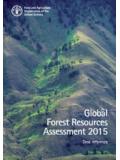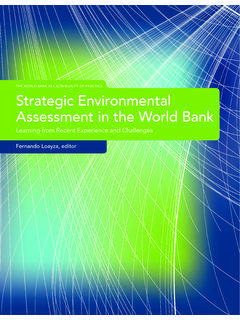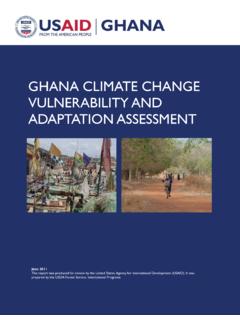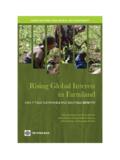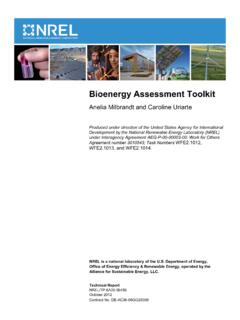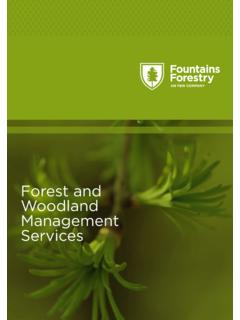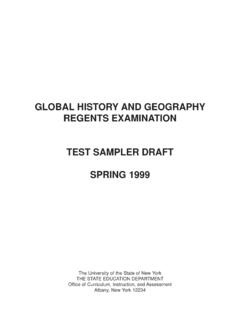Transcription of FRA 2015 Terms and Definitions - fao.org
1 FRA 2015 Terms and Definitionsdecember, 2012 forest resources assessment Working Paper 180 FOOD AND AGRICULTURE ORGANIZATION OF THE UNITED NATIONSRome, 2012 FRA 2015 Terms And deFiniTionsForest Resources assessment Working Paper 180 The forest Resources assessment ProgrammeThe global forest Resources assessment (FRA) benefits greatly from the consistent use of clear Terms and Definitions . It is conducted once every five years with the next assessment scheduled for release in September 2015. This document supports the preparation of FRA 2015 Country Reports by National Correspondents as well as the understanding of the underlying basis for what is reported in the welcome any comments, questions or suggestions you might have on this Working ,Kenneth MacDickenSenior Forestry Officer/Team Leader global forest Resources assessment TeamFAO Forestry DepartmentViale delle Terme di CaracallaRome 00153, ItalyE-mail: can also use the following e-mail address: More information on the global forest Resources assessment can be found at: forest Resources assessment (FRA) Working Paper Series is designed to reflect the activities and progress of the FRA Programme of FAO.
2 Working Papers are not authoritative information sources they do not reflect the official position of FAO and should not be used for official purposes. Please refer to the FAO forestry website ( ) for access to official FRA Working Paper Series provides an important forum for the rapid release of information related to the FRA programme. Should users find any errors in the documents or would like to provide comments for improving their quality they should contact Introduction 1 Structure of the document 2 Terms , Definitions and explanatory notes 31. forest and other wooded land 32. Natural and planted forest 63. Stocks and growth rates of the forests 84. forest production 115. Protection of soil and water and selective ecosystem services 136.
3 forest area protected and designated for the conservation on biodiversity 157. Woody invasive species 168. forest damage 169. Reduction in canopy cover 1710. forest policy and regulatory framework supporting implementation of SFM? 1711. National platform promoting stakeholder participation in forest policy 1712. forest area intended to be in permanent forest land use 1813. Measuring and reporting progress towards SFM at the national level 1814. forest under a forest management plan and monitoring 1915. Stakeholder involvement in management decision making for publicly owned forests 2017. Public revenue collection and expenditure 2118. Ownership and management rights of forests 2119. Employment in forestry 2420. Contribution of forestry to Gross Domestic Product (GDP) 2421. What is forest area likely to be in the future? 25 Additional Terms and Definitions 26 Alphabetical index 28 FRA 2015 Terms and Definitions1 IntroductionFAO has been coordinating global forest resources assessments every five to ten years since 1946.
4 The assessments have to a great extent contributed to the improvement of concepts, Definitions and methods related to forest resources assessments. Strong efforts have been made to harmonize and streamline reporting with other international forest -related processes within the framework of the Collaborative Partnership on forest (CPF), as well as with the partner organizations of the Collaborative forest Resources Questionnaire (CFRQ) and the scientific community, all in order to harmonize and improve forest related Definitions and reduce reporting burden on countries. The core Definitions build on earlier global assessments to ensure comparability over time. Whenever new Definitions are introduced or old Definitions modified this is done taking into consideration recommendations from experts in various in Definitions , however minor, may increase the risk of inconsistency in reporting over time.
5 High importance is thus given to ensure the continuity of the Definitions as applied in previous assessments in order to allow consistency of data over time whenever global Definitions are in a sense compromises and their application is subject to interpretation. Reducing national classifications to a set of global classes is a challenge and sometimes assumptions and approximations must be made. This working paper includes the Terms and Definitions applied in the country reporting process for FRA 2015 and the CFRQ and should be regarded as an authoritative document on the Terms and Definitions . The working paper can be used in meetings and training at all levels aiming to build national capacity for forest resources assessment and reporting in more details on FRA Programme, please see: FRA 2015 Terms and Definitions2 Structure of the documentThe Terms are structured according to the eight general topics and 21 questions in the country reports (Table 1).
6 The underlying rationale for this is that the context in which the definition is placed is of great importance for the understanding of the definition. Further, the Definitions often build on each other and only make sense in the right context. Definitions are provided for all Terms and categories reported on in the country reports for FRA 2015 and CFRQ. In addition, a number of closely related general and additional Terms are defined to further improve the understanding of the 1 Topic I: forest AREA AND forest CHARACTERISTICST opic II: PRODUCTIONT opic III: PROTECTIVE FUNCTIONS AND SELECTIVE ECOSYSTEM SERVICEST opic IV: bIODIVERSITY/ CONSERVATIONT opic V: DISTURbANCE AND forest DEGRADATIONT opic VI: MEASURING PROGRESS TOWARD SFMT opic VII: ECONOMICS/ LIVELIHOODST opic VIII: LOOKING FORWARDIn order to provide a good overview and facilitate the search of Terms , the Terms are also compiled in an alphabetical index (see page 28).
7 All Terms are printed in capital bold letters and the Definitions are found immediately below the term in bold font. Note that an underlined term in a definition indicates that a definition is available for that particular term, elsewhere in the document. Most Definitions are accompanied by explanatory notes. ExAMPLE 1 TERM, definition and explanatory notesTERMD efinition Explanatory note(s)FRA 2015 Terms and Definitions3 Terms , Definitions and explanatory notes1. forest AnD oThER wooDED lAnDTERM, definition and explanatory notesFoREST land spanning more than hectares with trees higher than 5 meters and a canopy cover of more than 10 percent, or trees able to reach these thresholds in situ. It does not include land that is predominantly under agricultural or urban land use. Explanatory notes1. forest is determined both by the presence of trees and the absence of other predominant land uses.
8 The trees should be able to reach a minimum height of 5 meters. 2. Includes areas with young trees that have not yet reached but which are expected to reach a canopy cover of at least 10 percent and tree height of 5 meters or more. It also includes areas that are temporarily unstocked due to clear-cutting as part of a forest management practice or natural disasters, and which are expected to be regenerated within 5 years. Local conditions may, in exceptional cases, justify that a longer time frame is Includes forest roads, firebreaks and other small open areas; forest in national parks, nature reserves and other protected areas such as those of specific environmental, scientific, historical, cultural or spiritual Includes windbreaks, shelterbelts and corridors of trees with an area of more than hectares and width of more than 20 Includes abandoned shifting cultivation land with a regeneration of trees that have, or are expected to reach, a canopy cover of at least 10 percent and tree height of at least 5 Includes areas with mangroves in tidal zones, regardless whether this area is classified as land area or Includes rubberwood, cork oak and Christmas tree plantations.
9 8. Includes areas with bamboo and palms provided that land use, height and canopy cover criteria are Excludes tree stands in agricultural production systems, such as fruit tree plantations, oil palm plantations, olive orchards and agroforestry systems when crops are grown under tree cover. Note: Some agroforestry systems such as the Taungya system where crops are grown only during the first years of the forest rotation should be classified as 2015 Terms and Definitions4oThER wooDED lAnDland not defined as forest , spanning more than hectares; with trees higher than 5 meters and a canopy cover of 5-10 percent, or trees able to reach these thresholds; or with a combined cover of shrubs, bushes and trees above 10 percent. It does not include land that is predominantly under agricultural or urban land notes1. The definition above has two options: The canopy cover of trees is between 5 and 10 percent; trees should be higher than 5 meters or able to reach 5 The canopy cover of trees is less than 5 percent but the combined cover of shrubs, bushes and trees is more than 10 percent.
10 Includes areas of shrubs and bushes where no trees are Includes areas with trees that will not reach a height of at least 5 meters and with a canopy cover of 10 percent or more, some alpine tree vegetation types, arid zone mangroves, Includes areas with bamboo and palms provided that land use, height and canopy cover criteria are lAnDAll land that is not classified as forest or other wooded notes4. Includes agricultural land, meadows and pastures, built-up areas, barren land, land under permanent ice, etc. 5. Includes all areas classified under the sub-category Other land with tree cover .oThER lAnD wITh TREE CoVER (Sub-category)land considered as other land , that is predominantly agricultural or urban lands use and has patches of tree cover that span more than hectares with a canopy cover of more than 10 percent of trees able to reach a height of 5 meters at maturity.










